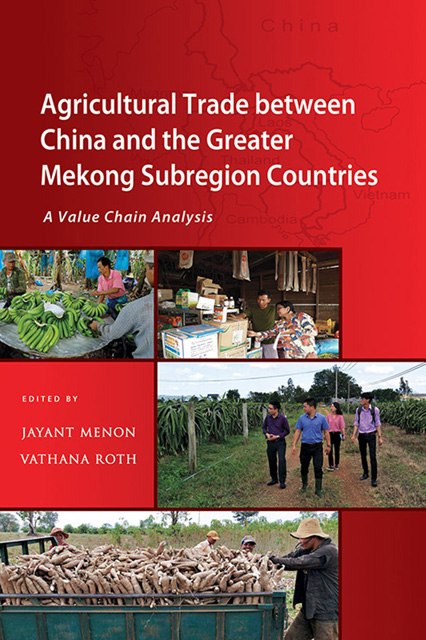Book contents
- Frontmatter
- Contents
- List of Tables
- List of Figures
- List of Annexes
- Foreword
- Preface
- Acknowledgements
- Abbreviations and Acronyms
- The Contributors
- 1 Agricultural Trade between China and the Greater Mekong Subregion Countries: An Overview
- 2 Economic Structural Change in China and the Implications for Agricultural Trade in the Lancang-Mekong Region
- 3 Agricultural Exports from Thailand to China: A Value Chain Analysis of Cassava and Durian
- 4 Agricultural Exports from Cambodia to China: A Value Chain Analysis of Cassava and Sugarcane
- 5 Agricultural Exports from Laos to China: A Value Chain Analysis of Rice and Cavendish Banana
- 6 Agricultural Exports from Myanmar to China: A Value Chain Analysis of Maize
- 7 Agricultural Exports from Vietnam to China: A Value Chain Analysis of Dragon Fruit and Coffee
- Index
1 - Agricultural Trade between China and the Greater Mekong Subregion Countries: An Overview
Published online by Cambridge University Press: 30 June 2023
- Frontmatter
- Contents
- List of Tables
- List of Figures
- List of Annexes
- Foreword
- Preface
- Acknowledgements
- Abbreviations and Acronyms
- The Contributors
- 1 Agricultural Trade between China and the Greater Mekong Subregion Countries: An Overview
- 2 Economic Structural Change in China and the Implications for Agricultural Trade in the Lancang-Mekong Region
- 3 Agricultural Exports from Thailand to China: A Value Chain Analysis of Cassava and Durian
- 4 Agricultural Exports from Cambodia to China: A Value Chain Analysis of Cassava and Sugarcane
- 5 Agricultural Exports from Laos to China: A Value Chain Analysis of Rice and Cavendish Banana
- 6 Agricultural Exports from Myanmar to China: A Value Chain Analysis of Maize
- 7 Agricultural Exports from Vietnam to China: A Value Chain Analysis of Dragon Fruit and Coffee
- Index
Summary
INTRODUCTION
The Greater Mekong Subregion (GMS) encompasses five Southeast Asian countries—Cambodia, Laos, Myanmar, Thailand and Vietnam—and China. These six countries had a total population of 1.6 billion in 2018.
More than two decades of market-oriented reforms and rapid economic growth have transformed the GMS into one of the most dynamic subregions in Asia. With the exception of Thailand, GMS countries have grown at an average annual rate of more than 7 per cent in the last twenty-five years, placing them among the ranks of high-growth economies. GDP per capita growth has likewise been impressive, averaging roughly 8 per cent in China and Myanmar, and over 5 per cent in Cambodia, Laos and Vietnam since 1995. Across all six countries of the GMS, the structure of the economy has shifted from agriculture to industry and services (Table 1.1). The GMS countries are at different stages of transitioning to commercial agriculture. Whereas Thailand, Vietnam and China already have large commercial agricultural sectors, Cambodia and Laos are well behind, with much lower levels of commercial agricultural activity.
While agriculture’s share of the economy is declining across the subregion, the sector remains a critical one for growth and poverty reduction. Agriculture still accounted for nearly a quarter of GDP in Cambodia and Myanmar in 2018. With the exception of China, the majority of the population in GMS countries continues to live in rural areas. Agriculture also remains a major source of employment in GMS countries, accounting for between 27 per cent and 68 per cent of total employment in 2018. More importantly, poverty remains a largely rural phenomenon in GMS countries (Table 1.2).
Empirical studies underscore the importance of agriculture in reducing poverty. The World Bank (2007) estimates that growth driven by agriculture is between two to four times more effective at reducing poverty than other sectors. Using time-series and cross-section regression analysis covering twenty-five countries, Cervantes-Godoy and Dewbre (2010) confirm this finding by showing that although economic growth is an important contributor to poverty reduction, the sector mix of growth matters greatly, with growth in agricultural incomes being particularly important. Moreover, agriculture’s linkages to manufacturing and services—through the processing, packaging and transport of agricultural products—create multiplier effects that contribute further to economic growth.
- Type
- Chapter
- Information
- Agricultural Trade between China and the Greater Mekong Subregion CountriesA Value Chain Analysis, pp. 1 - 21Publisher: ISEAS–Yusof Ishak InstitutePrint publication year: 2022

